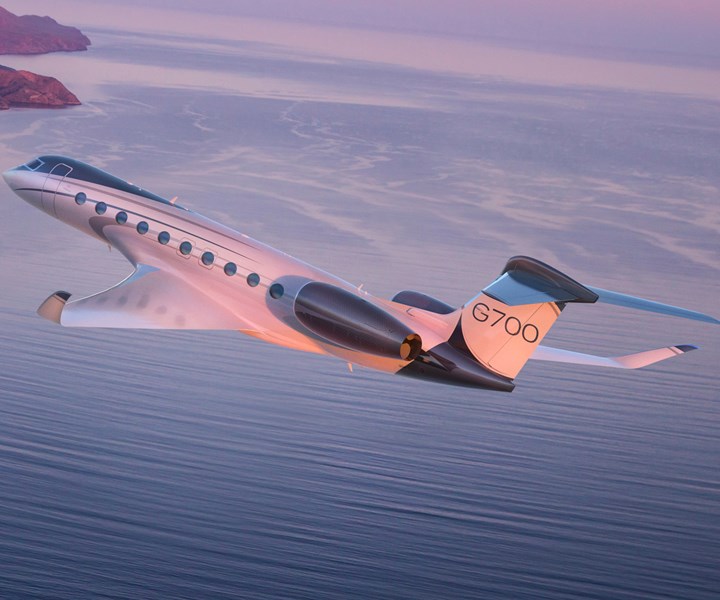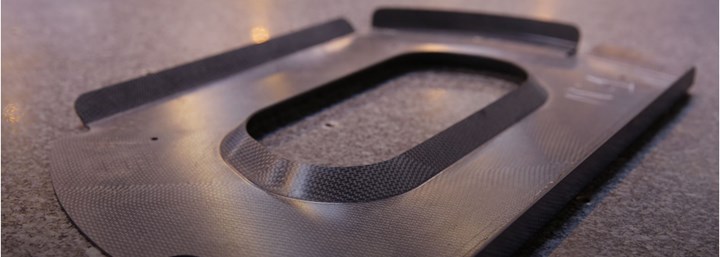Daher composite-metal winglets enhance performance of new Gulfstream G-700 large-cabin bizjet
The winglets are manufactured at the Daher factory in Tarbes, France and assembled into the aircraft at the Gulfstream’s Savannah plant.

Source | Gulfstream Aerospace Corp.
Gulfstream Aerospace Corp.’s (Savannah, Ga., U.S.) all-new G700 features performance-enhancing winglets built by Daher (Paris, France), contributing to the twin-engine business jet’s fuel efficiency and ultralong-range.
Daher produces the winglets — upward-curved, aerodynamic extensions at the aircraft’s wingtips — using both composite and metal components, achieving both optimized weight and enhanced aesthetics. They are manufactured at the Daher factory in Tarbes, France and assembled into the aircraft at the Gulfstream’s Savannah plant.
Winglets reduce aerodynamic drag caused by turbulent airflow at the ends of wings, while also increasing the wings’ lift. The winglets, which Daher designed to Gulfstream’s aerodynamic shape and specifications, play a role in the G700’s excellent flight range of up to 7,500 nautical miles/13,890 kilometers.
Daher CEO Didier Kayat noted that the G700 winglets follows Daher’s development and supply of complex parts for other Gulfstream business jet programs, including the composite wing-to-body fairing and main landing gear doors on the G500 and G600, the G600’s elevator, and the bullet fairing for the G650.
Aircraft OEM and thermoplastic composites leader
Daher is not just a parts manufacturer, but also an aircraft OEM. This becomes an asset as it pushes forward from its position as a leader in the mass production of thermoplastic (TP) composites. “It produces a TP component every 3 minutes,” says Pierre Rouch, TP composite technical expert at Daher. In a Nov 2019 press release, the company asserts that its status as an aircraft manufacturer gives it assets that set it apart from the rest of the field.
“Qualification is the central issue. We must be able to demonstrate that the components we design will be able to withstand everything an aircraft experiences without becoming damaged in the process. As an aircraft manufacturer, we have both the qualification/certification mindset and the ability to conduct tests on our own aircraft. That makes us truly unique.” — Jean-Luc Daligault, head of the Aerostructures Business Line at Daher
“We’re now at a pivotal moment for thermoplastic [composites], which is coming of age and emerging as a real game changer in the world of aerostructures,” says Daligault. “It allows us to produce lighter, stronger, components than was possible with the metals previously used, and to do so at lower cost and higher speed. Significant performance gains in terms of weight reduction, fuel savings, high-temperature resistance and improved tolerance to damage and stress, together with the opportunity to limit the environmental impact of air transport, explain the enthusiasm for this material in the aerospace industry supply chain.

Source | Daher
“Nantes is THE Daher dedicated site for thermoplastic composites,” notes Rouch. The 160,000 components produced every year by the site’s two automated production lines include moving parts, small ribs, nearly a thousand different types of clips, floor structures and even engine cowls for several major aerospace programs.
Its high-throughput performance and state-of-the-art production resulted in the Daher plant in Nantes being awarded one of France’s very first Vitrine Technologique (Technology Showcase) labels in 2015 by a group of industry organizations, including the French Aerospace Industries Association (GIFAS), which has produced a roadmap for the development of a future European TP sector.

Source | Daher
Innovative structures and processes
Daher is now focused on developing thicker components and structural components subject to high stresses. Successful tests conducted by Daher include the large wing ribs developed two years ago as part of an innovation program led by the French Civil Aviation Research Council (CORAC). “These deliver a weight saving of just over 35% at the same cost as aluminum,” continues Pierre Rouch.
As a partner in the Wings of Tomorrow (WoT) project alongside Airbus, Daher is responsible for the design and manufacture of five high-load thermoplastic ribs. These will be delivered during 2020 for installation in the first full-scale demonstrator.
Following its 2019 acquisition of KVE Composites (The Hague, Netherlands), which specializes in thermoplastic composites welding, Daher has been able to introduce a niche TP induction welding technology. This innovative process can potentially reduce the number of rivets and the overall weight of the application concerned by an additional 15%.
(Note, KVE Composites is also part of the Clean Sky 2 MECATESTERS project, demonstrating a full-scale, welded thermoplastic-composite aircraft fuselage.)
So what might the future hold?
One of Daher’s central goals is to improve its ability to recover and process production offcuts and recycle end-of-life TP components. At the same time, and beyond applications in wings, TP is already continuing to expand its applications into many different areas of aircraft construction and maintenance. “In terms of thermoplastics, Daher is currently working on around ten other projects and trials, and all these technological innovations will — of course — one day find their way into our own aircraft,” concludes Pierre Rouch.
Related Content
Cryo-compressed hydrogen, the best solution for storage and refueling stations?
Cryomotive’s CRYOGAS solution claims the highest storage density, lowest refueling cost and widest operating range without H2 losses while using one-fifth the carbon fiber required in compressed gas tanks.
Read MoreBio-based acrylonitrile for carbon fiber manufacture
The quest for a sustainable source of acrylonitrile for carbon fiber manufacture has made the leap from the lab to the market.
Read MoreTU Munich develops cuboidal conformable tanks using carbon fiber composites for increased hydrogen storage
Flat tank enabling standard platform for BEV and FCEV uses thermoplastic and thermoset composites, overwrapped skeleton design in pursuit of 25% more H2 storage.
Read MorePlant tour: Joby Aviation, Marina, Calif., U.S.
As the advanced air mobility market begins to take shape, market leader Joby Aviation works to industrialize composites manufacturing for its first-generation, composites-intensive, all-electric air taxi.
Read MoreRead Next
“Structured air” TPS safeguards composite structures
Powered by an 85% air/15% pure polyimide aerogel, Blueshift’s novel material system protects structures during transient thermal events from -200°C to beyond 2400°C for rockets, battery boxes and more.
Read MoreDeveloping bonded composite repair for ships, offshore units
Bureau Veritas and industry partners issue guidelines and pave the way for certification via StrengthBond Offshore project.
Read MoreAll-recycled, needle-punched nonwoven CFRP slashes carbon footprint of Formula 2 seat
Dallara and Tenowo collaborate to produce a race-ready Formula 2 seat using recycled carbon fiber, reducing CO2 emissions by 97.5% compared to virgin materials.
Read More

























